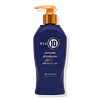What's inside
What's inside
 Key Ingredients
Key Ingredients

No key ingredients
 Benefits
Benefits

 Concerns
Concerns

 Ingredients Side-by-side
Ingredients Side-by-side

Cyclopentasiloxane
EmollientDimethiconol
EmollientHydrolyzed Keratin
HumectantPrunus Amygdalus Dulcis Oil
Skin ConditioningMauritia Flexuosa Fruit Oil
Skin ConditioningCinnamidopropyltrimonium Chloride
Argania Spinosa Kernel Oil
EmollientIsohexadecane
EmollientAlpha-Isomethyl Ionone
PerfumingPolysilicone-15
UV FilterKeratin Amino Acids
Skin ConditioningOenothera Biennis Oil
EmollientSesamum Indicum Seed Oil
EmollientParfum
MaskingLinalool
PerfumingHexyl Cinnamal
PerfumingButylphenyl Methylpropional
PerfumingHydroxyisohexyl 3-Cyclohexene Carboxaldehyde
MaskingCitronellol
PerfumingLimonene
PerfumingBenzyl Benzoate
AntimicrobialCyclopentasiloxane, Dimethiconol, Hydrolyzed Keratin, Prunus Amygdalus Dulcis Oil, Mauritia Flexuosa Fruit Oil, Cinnamidopropyltrimonium Chloride, Argania Spinosa Kernel Oil, Isohexadecane, Alpha-Isomethyl Ionone, Polysilicone-15, Keratin Amino Acids, Oenothera Biennis Oil, Sesamum Indicum Seed Oil, Parfum, Linalool, Hexyl Cinnamal, Butylphenyl Methylpropional, Hydroxyisohexyl 3-Cyclohexene Carboxaldehyde, Citronellol, Limonene, Benzyl Benzoate
Water
Skin ConditioningSodium Laureth Sulfate
CleansingCocamidopropyl Betaine
CleansingPEG-7 Glyceryl Cocoate
EmulsifyingSodium Chloride
MaskingNymphaea Caerulea Flower Extract
Skin ConditioningGlycine
BufferingLysine Hcl
Skin ConditioningHydrolyzed Keratin
HumectantDisodium Cocoamphodiacetate
CleansingParfum
MaskingSodium Benzoate
MaskingCitric Acid
BufferingCocamide Mea
EmulsifyingDimethicone
EmollientGuar Hydroxypropyltrimonium Chloride
Skin ConditioningGlycol Distearate
EmollientHydrogenated Castor Oil
EmollientLaureth-4
EmulsifyingPropylene Glycol
HumectantSodium Hydroxide
BufferingLinalool
PerfumingLaureth-23
CleansingSalicylic Acid
MaskingPhenoxyethanol
PreservativePotassium Sorbate
PreservativeWater, Sodium Laureth Sulfate, Cocamidopropyl Betaine, PEG-7 Glyceryl Cocoate, Sodium Chloride, Nymphaea Caerulea Flower Extract, Glycine, Lysine Hcl, Hydrolyzed Keratin, Disodium Cocoamphodiacetate, Parfum, Sodium Benzoate, Citric Acid, Cocamide Mea, Dimethicone, Guar Hydroxypropyltrimonium Chloride, Glycol Distearate, Hydrogenated Castor Oil, Laureth-4, Propylene Glycol, Sodium Hydroxide, Linalool, Laureth-23, Salicylic Acid, Phenoxyethanol, Potassium Sorbate
 Reviews
Reviews

Alternatives
Ingredients Explained
These ingredients are found in both products.
Ingredients higher up in an ingredient list are typically present in a larger amount.
Hydrolyzed Keratin is derived from keratin. Keratin is a large protein that is naturally found in our hair and skin.
Studies show keratin is able to seal broken hair cuticles, helping to prevent split ends and breakage.
As a humectant, hydrolyzed keratin helps draw moisture from the air to your hair and skin. This helps keep your skin and hair hydrated.
Learn more about Hydrolyzed KeratinLinalool is a fragrance and helps add scent to products. It's derived from common plants such as cinnamon, mint, citrus, and lavender.
Like Limonene, this ingredient oxidizes when exposed to air. Oxidized linalool can cause allergies and skin sensitivity.
This ingredient has a scent that is floral, spicy tropical, and citrus-like.
Learn more about LinaloolParfum is a catch-all term for an ingredient or more that is used to give a scent to products.
Also called "fragrance", this ingredient can be a blend of hundreds of chemicals or plant oils. This means every product with "fragrance" or "parfum" in the ingredients list is a different mixture.
For instance, Habanolide is a proprietary trade name for a specific aroma chemical. When used as a fragrance ingredient in cosmetics, most aroma chemicals fall under the broad labeling category of “FRAGRANCE” or “PARFUM” according to EU and US regulations.
The term 'parfum' or 'fragrance' is not regulated in many countries. In many cases, it is up to the brand to define this term.
For instance, many brands choose to label themselves as "fragrance-free" because they are not using synthetic fragrances. However, their products may still contain ingredients such as essential oils that are considered a fragrance by INCI standards.
One example is Calendula flower extract. Calendula is an essential oil that still imparts a scent or 'fragrance'.
Depending on the blend, the ingredients in the mixture can cause allergies and sensitivities on the skin. Some ingredients that are known EU allergens include linalool and citronellol.
Parfum can also be used to mask or cover an unpleasant scent.
The bottom line is: not all fragrances/parfum/ingredients are created equally. If you are worried about fragrances, we recommend taking a closer look at an ingredient. And of course, we always recommend speaking with a professional.
Learn more about Parfum